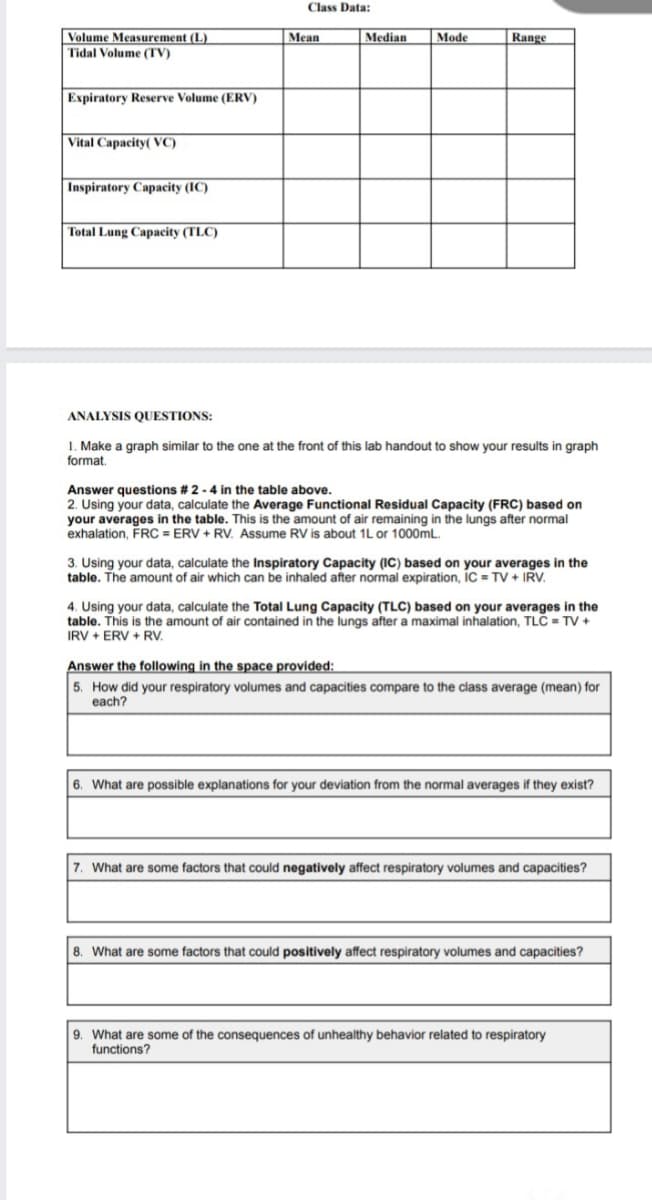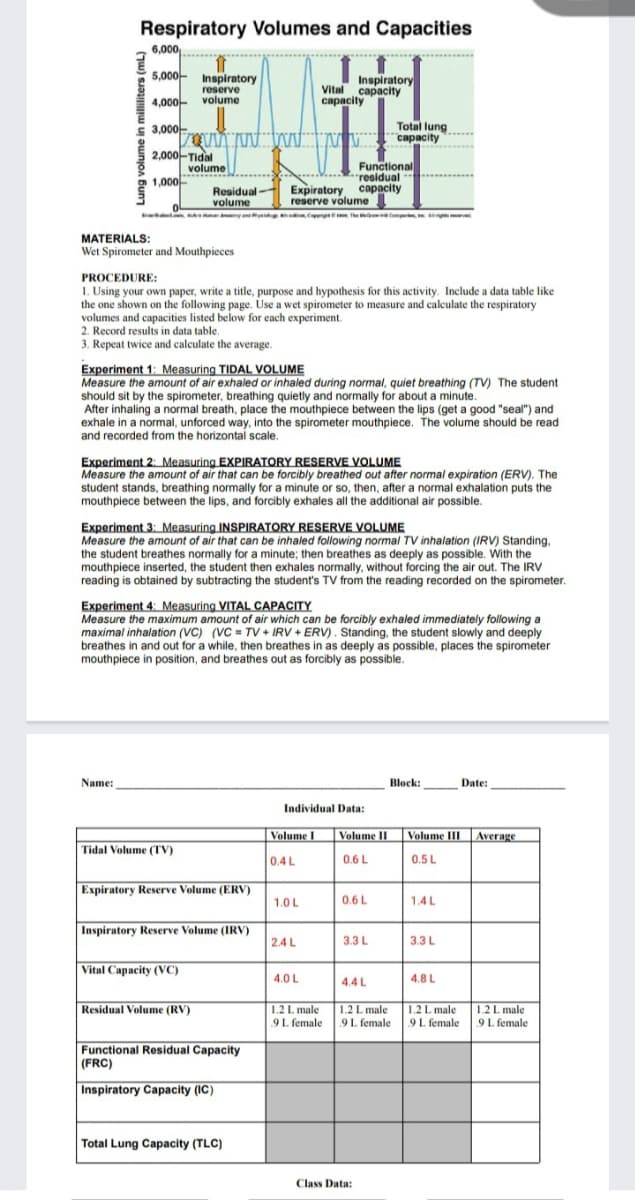ANALYSIS QUESTIONS: 1. Make a graph similar to the one at the front of this lab handout to show your results in graph format. Answer questions # 2 -4 in the table above. 2. Using your data, calculate the Average Functional Residual Capacity (FRC) based on your averages in the table. This is the amount of air remaining in the lungs after normal exhalation, FRC = ERV + RV. Assume RV is about 1L or 1000mL. 3. Using your data, calculate the Inspiratory Capacity (IC) based on your averages in the table. The amount of air which can be inhaled after normal expiration, IC = TV + IRV. 4. Using your data, calculate the Total Lung Capacity (TLC) based on your averages in the table. This is the amount of air contained in the lungs after a maximal inhalation, TLC = TV + IRV + ERV + RV.
ANALYSIS QUESTIONS: 1. Make a graph similar to the one at the front of this lab handout to show your results in graph format. Answer questions # 2 -4 in the table above. 2. Using your data, calculate the Average Functional Residual Capacity (FRC) based on your averages in the table. This is the amount of air remaining in the lungs after normal exhalation, FRC = ERV + RV. Assume RV is about 1L or 1000mL. 3. Using your data, calculate the Inspiratory Capacity (IC) based on your averages in the table. The amount of air which can be inhaled after normal expiration, IC = TV + IRV. 4. Using your data, calculate the Total Lung Capacity (TLC) based on your averages in the table. This is the amount of air contained in the lungs after a maximal inhalation, TLC = TV + IRV + ERV + RV.
Biomedical Instrumentation Systems
1st Edition
ISBN:9781133478294
Author:Chatterjee
Publisher:Chatterjee
Chapter11: Instrumentation In Respiration
Section: Chapter Questions
Problem 1P
Related questions
Question
Do the averages and a graph

Transcribed Image Text:Volume Measurement (L)
Tidal Volume (TV)
Expiratory Reserve Volume (ERV)
Vital Capacity(VC)
Inspiratory Capacity (IC)
Total Lung Capacity (TLC)
Class Data:
Mean
Median
Mode
Range
ANALYSIS QUESTIONS:
1. Make a graph similar to the one at the front of this lab handout to show your results in graph
format.
Answer questions # 2 -4 in the table above.
2. Using your data, calculate the Average Functional Residual Capacity (FRC) based on
your averages in the table. This is the amount of air remaining in the lungs after normal
exhalation, FRC = ERV + RV. Assume RV is about 1L or 1000mL.
3. Using your data, calculate the Inspiratory Capacity (IC) based on your averages in the
table. The amount of air which can be inhaled after normal expiration, IC = TV + IRV.
4. Using your data, calculate the Total Lung Capacity (TLC) based on your averages in the
table. This is the amount of air contained in the lungs after a maximal inhalation, TLC = TV +
IRV + ERV + RV.
Answer the following in the space provided:
5. How did your respiratory volumes and capacities compare to the class average (mean) for
each?
6. What are possible explanations for your deviation from the normal averages if they exist?
7. What are some factors that could negatively affect respiratory volumes and capacities?
8. What are some factors that could positively affect respiratory volumes and capacities?
9. What are some of the consequences of unhealthy behavior related to respiratory
functions?

Transcribed Image Text:Respiratory Volumes and Capacities
6,000,
1
5,000 Inspiratory
4,000 volume
3,000-
Name:
reserve
2,000 Tidal
1,000
www w MM
MATERIALS:
Wet Spirometer and Mouthpieces
volume
Residual-
volume
Tidal Volume (TV)
PROCEDURE:
1. Using your own paper, write a title, purpose and hypothesis for this activity. Include a data table like
the one shown on the following page. Use a wet spirometer to measure and calculate the respiratory
volumes and capacities listed below for each experiment.
2. Record results in data table.
3. Repeat twice and calculate the average.
Experiment 1: Measuring TIDAL VOLUME
Measure the amount of air exhaled or inhaled during normal, quiet breathing (TV) The student
should sit by the spirometer, breathing quietly and normally for about a minute.
After inhaling a normal breath, place the mouthpiece between the lips (get a good "seal") and
exhale in a normal, unforced way, into the spirometer mouthpiece. The volume should be read
and recorded from the horizontal scale.
Vital Capacity (VC)
Experiment 2: Measuring EXPIRATORY RESERVE VOLUME
Measure the amount of air that can be forcibly breathed out after normal expiration (ERV). The
student stands, breathing normally for a minute or so, then, after a normal exhalation puts the
mouthpiece between the lips, and forcibly exhales all the additional air possible.
Expiratory Reserve Volume (ERV)
Experiment 3: Measuring INSPIRATORY RESERVE VOLUME
Measure the amount of air that can be inhaled following normal TV inhalation (IRV) Standing,
the student breathes normally for a minute; then breathes as deeply as possible. With the
mouthpiece inserted, the student then exhales normally, without forcing the air out. The IRV
reading is obtained by subtracting the student's TV from the reading recorded on the spirometer.
Inspiratory Reserve Volume (IRV)
Residual Volume (RV)
Experiment 4: Measuring VITAL CAPACITY
Measure the maximum amount of air which can be forcibly exhaled immediately following a
maximal inhalation (VC) (VC=TV+ IRV + ERV). Standing, the student slowly and deeply
breathes in and out for a while, then breathes in as deeply as possible, places the spirometer
mouthpiece in position, and breathes out as forcibly as possible.
Functional
residual
Expiratory capacity
reserve volume
Functional Residual Capacity
(FRC)
Inspiratory Capacity (IC)
Vital capacity
capacity
Total Lung Capacity (TLC)
Inspiratory
Volume I
0.4L
Individual Data:
1.0 L
2.4L
4.0 L
1.2 L male
9 L female
Total lung
capacity
Volume II
0.6 L
0.6 L
3.3 L
4.4L
Class Data:
1.2 L male
9 L female.
......
Block:
1.4 L
Volume III Average
0.5 L
3.3 L
4.8 L
Date:
1.2 L male
9 L female
1.2 L male
.9 L female
Expert Solution
This question has been solved!
Explore an expertly crafted, step-by-step solution for a thorough understanding of key concepts.
Step by step
Solved in 4 steps with 3 images

Recommended textbooks for you


Human Physiology: From Cells to Systems (MindTap …
Biology
ISBN:
9781285866932
Author:
Lauralee Sherwood
Publisher:
Cengage Learning

Basic Clinical Lab Competencies for Respiratory C…
Nursing
ISBN:
9781285244662
Author:
White
Publisher:
Cengage


Human Physiology: From Cells to Systems (MindTap …
Biology
ISBN:
9781285866932
Author:
Lauralee Sherwood
Publisher:
Cengage Learning

Basic Clinical Lab Competencies for Respiratory C…
Nursing
ISBN:
9781285244662
Author:
White
Publisher:
Cengage

Human Biology (MindTap Course List)
Biology
ISBN:
9781305112100
Author:
Cecie Starr, Beverly McMillan
Publisher:
Cengage Learning

Cardiopulmonary Anatomy & Physiology
Biology
ISBN:
9781337794909
Author:
Des Jardins, Terry.
Publisher:
Cengage Learning,

Anatomy & Physiology
Biology
ISBN:
9781938168130
Author:
Kelly A. Young, James A. Wise, Peter DeSaix, Dean H. Kruse, Brandon Poe, Eddie Johnson, Jody E. Johnson, Oksana Korol, J. Gordon Betts, Mark Womble
Publisher:
OpenStax College